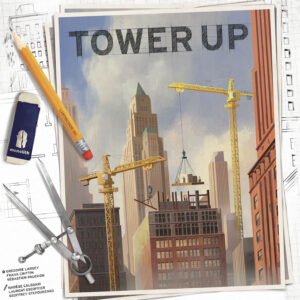 As a kid, I was interested in big machinery and all the activities around a construction site. I was equally enthralled when I first visited New York City at the vast skyline of skyscrapers that were built by those workers depicted in so many iconic photographs.
As a kid, I was interested in big machinery and all the activities around a construction site. I was equally enthralled when I first visited New York City at the vast skyline of skyscrapers that were built by those workers depicted in so many iconic photographs.
You can imagine how my bubble burst when I realized that you could continue to add more floors to a building that already has a roof on it. I’m sure you’re wondering what I’m talking about, but trust me, I’m an engineer.
Tower Up is a game about building skyscrapers and working with city planning to achieve objectives. It plays 2-4 players in about 15-20 minutes per player and won’t expose you to any fall hazards unless your gaming setup is really weird. And if it is, you should probably address that, because your safety is important to the Board Game Quest team.
Gameplay Overview:
One your turn you can either draw a resource card or start a building.
Drawing a card gives you the resources on it and/or allows you to move one of your score track vehicles up its track. Additionally, if you end up with more than 10 building resources in your supply, you must discard down to 10.
When you start a building, you have to place a resource in an empty space adjacent to an existing building. That block cannot match the color of any other adjacent building, where adjacency is shown by streets between the buildings. Then you must add a matching floor to all adjacent buildings, even if they have a roof on them.
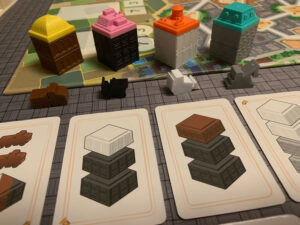
Then, you get to add a roof tile to one of the buildings to which you just added blocks. Lastly, move your score track vehicle up by the number of floors that the newly roofed building has.
If all four of your vehicles are at or past a column of stars on their tracks you can take an extra turn which can be either drawing a card or starting a building.
Each game also features three objective cards for having presence (roof tiles) in each sector of the town, having presence in buildings surrounded by parks, buildings with water features/pools, etc. When you achieve an objective, take the highest-value objective token and place it on your board.
The game continues until one player has used all their roof tiles at which point they count the number of roofs they have on top of buildings and place their cone at the appropriate spot on their player board. Then each other player gets a final turn and counts and scores their roofs. Final scores, which represent millions of dollars, Euros, or money units of your choice are calculated by adding the value above each of the scoring track, the cones, and the values of the objective tokens. The highest score wins.
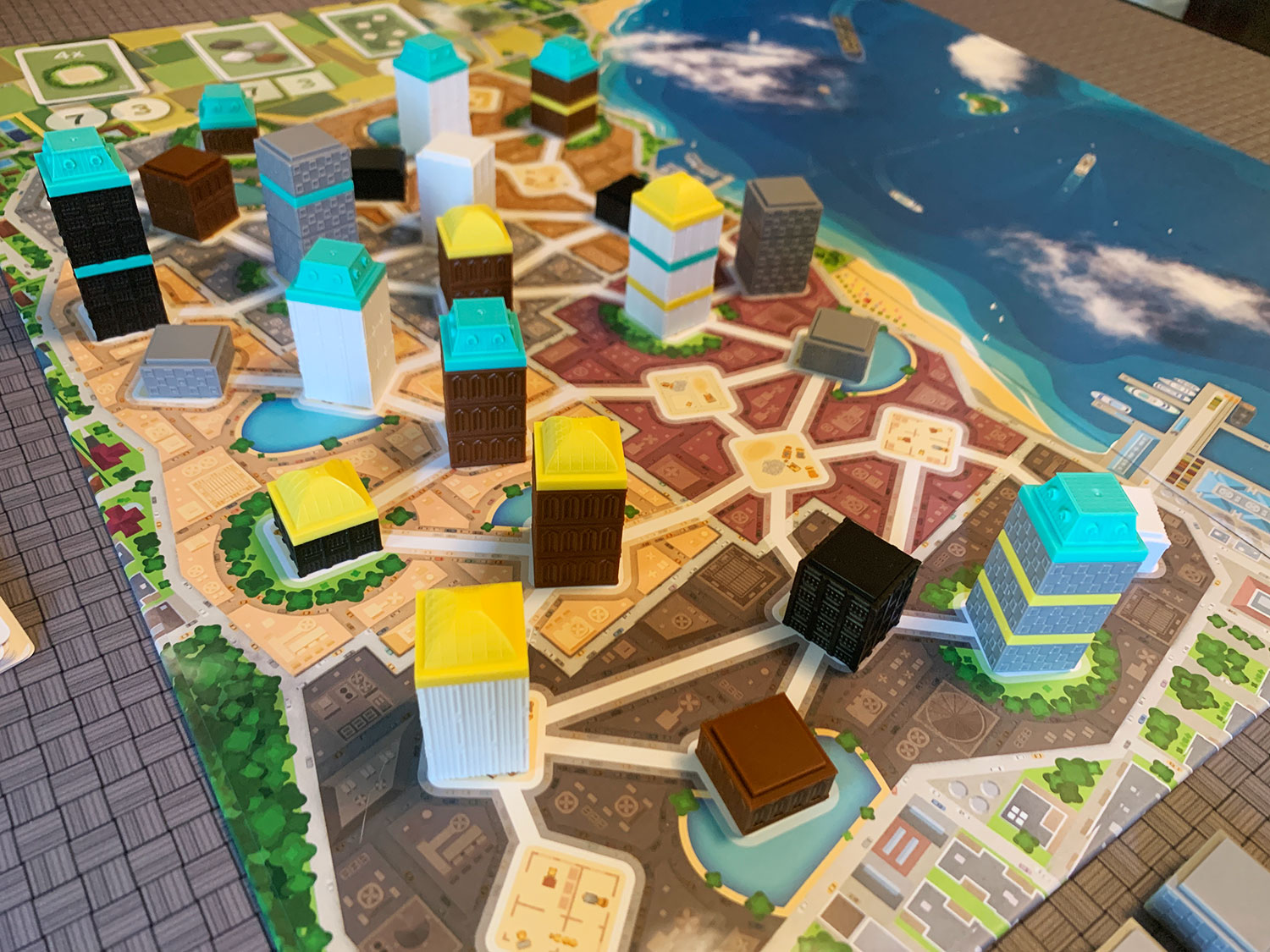
Game Experience:
Tower Up has a great table presence and is centered around a very simple mechanic. The placement rules are easy to explain, and the game really flows once the concept sticks. The setup is also incredibly fast with one of the two trays from the box being set on the table, some cards shuffled, and three objective cards and scoring tokens placed on the board. That’s an important feature for me in a relatively quick-playing game.
There’s a great toy factor to Tower Up as the city gets built between the building blocks and the different vehicles moving along the tracks. It’s a tiny detail, but I love how each building and roof colors are different designs giving the budding skyline a broader appearance. I also really appreciated how the game uses different sides of the board for a two-player and a three and four-player game.
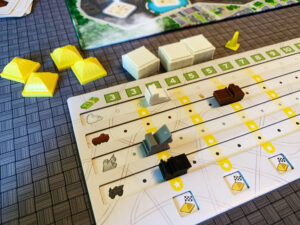
This is not a complicated game, and I think there’s a nice amount of crunch as you attempt to maximize your scores by pulling different levers like you’re operating a crane. Having to choose between gathering resources or building is interesting, especially with some of the resource cards granting movement up the different tracks and getting you closer to an extra turn. I often found that my extra turns were spent gathering resources, having functionally exhausted my supply during the turn that I just scored. I tended to run lean on resources, spending them as quickly as I earned them like a gamer blowing through their budget in a game store. Resources also break ties so a little hoarding can be beneficial while the resource cap encourages constant spending.
The game arc fittingly goes from open roads to rush hour congestion as the number of free spaces dwindles and you wish the engineers had planned the city out better. Three-player games have the most open space so is probably the coziest player count.
Player interactions are indirect as you’ll be simultaneously helping and blocking each other with new constructions. And sometimes you’re eyeing a resource card and it gets taken before your turn but that’s about it for player interaction. Until towards the end of the game, losing the spot you wanted to build on feels just like a minor setback and there’s usually another space to work towards the same end goals. Since points come from various sources, the difference between the third floor of a brown building and the fourth floor of a white building may not be earth shattering. And more likely completing objectives earlier, having more exposed roofs, and trying to maximize the number of free turns you get is probably a more viable strategy than just slamming one track to the top.
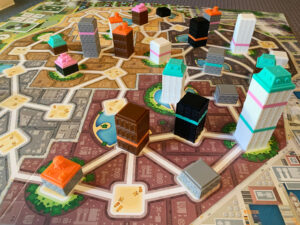
But scoring is tight and two of the first few games I played ended in ties (and both times one player had more resources left over) and I expect that holds true as players gain more experience. The other games were fairly tight in scoring too. The positive here is the tight scoring makes games feel close and while you can sum everyone’s scores as you go (also screeching the game’s progression to a halt like someone rubber necking an accident on a freeway), the final will change as the number of roofs fluctuate.
As I try to find things to critique, I’m kind of coming up blank for any major criticisms. Production-wise, the cards didn’t fit perfectly in the discard tray is a pedantic comment (and if you sleeve cards the tray may not work on the whole). And despite the green and blue on the board, the game is a lot of tans and grays so, buildings aside, the board is a little plain/drab looking. Lastly, this isn’t a deep game so people who want a really deep and crunchy Lacerda game may come away feeling a little empty.
Final Thoughts:
Rome wasn’t built in a day, but this modern metropolis should be built in about an hour. There’s a lot to like, especially if you want a lighter strategy game. I think the toy factor in Tower Up will have some broad appeal and could entice people to play something that might seem more complicated than it is.
Final Score: 4 Stars – Tower Up is a snappy building construction game with fun components and accessible gameplay.
 Hits:
Hits:
• Easy to teach with snappy turns
• Great toy factor/table presence
• Really tight scoring
Misses:
• Winning can come down to who has more parts left over
• Board, without buildings, is slightly bland/boring looking
Source: Board Game Quest



